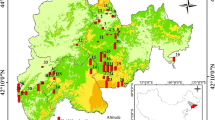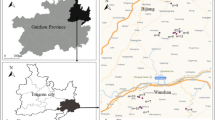Abstract
Purpose
Soil is a major pool of anthropogenically emitted mercury (Hg) and will in turn be a source of atmospheric Hg contamination. It was hypothesized that accumulation of anthropogenic Hg in the soil at a regional scale is associated with the amount of Hg emitted to the atmosphere and soil type.
Materials and methods
A total of 448 horizon samples were collected from the typical soil types of the Yangtze River Delta and Pearl River Delta. Titanium (Ti) was selected as a reference element to discriminate anthropogenic Hg from the Hg associated with pedogenic processes. Soil pools of anthropogenic Hg were quantified to show the difference in Hg sequestration among soil types and regions.
Results and discussion
Soil pools of anthropogenic Hg ranged from 0.70 to 6971 g/ha in the Yangtze River Delta (YRD) and from 35.81 to 13098.71 g/ha in the Pearl River Delta (PRD). The estimated soil Hg pools were well correlated with the amounts of Hg emitted in these two regions. Soil properties, namely organic matter content, amorphous iron oxides, and cation exchange capacity, were significantly (p < 0.01) and positively correlated with soil Hg accumulation. Meanwhile, soil organic matter was the most important factor to determine the depth distribution of Hg in soil profile of the majority of soils. Perudic Cambisols and Stagnic Anthrosols which contained higher content of amorphous iron oxides had the highest soil Hg pools, indicating the importance of amorphous iron oxides other than organic matter to the Hg retention in soil. Soil and soil horizons with low pH and high salinity did show a low accumulation of Hg probably due to the remobilization of Hg under such conditions.
Conclusions
In addition to the amount of Hg emitted, soil types may be a major factor in controlling the sequestration of anthropogenic Hg in both regions. Stagnic Anthrosols are an important pool for retention of anthropogenic Hg.



Similar content being viewed by others
References
Burt R, Wilson MA, Mays MD, Lee CW (2003) Major and trace elements of selected pedons in the USA. J Environ Qual 32(6):2109–2121
Chen LG, Xu ZC, Ding XY, Zhang WD, Huang YM, Fan RF, Sun JR, Liu M, Qian DL, Feng YB (2012) Spatial trend and pollution assessment of total mercury and methylmercury pollution in the Pearl River Delta soil, South China. Chemosphere 88(5):612–619
Cheng K, Xue ZG, Zhang ZQ, Li H, Yi P, Wang YH, Xu YX (2009) Emission and control of air pollutants in major industries of Yangtze Delta. Environ Sci Technol (China) 32(9):120–123
Feng XB, Qiu GL (2008) Mercury pollution in Guizhou, Southwestern China—an overview. Sci Total Environ 400(1–3):227–237
Grigal DF (2002) Inputs and outputs of mercury from terrestrial watersheds: a review. Environ Rev 10(1):1–39
Grimaldi C, Grimaldi M, Guedron S (2008) Mercury distribution in tropical soil profiles related to origin of mercury and soil processes. Sci Total Environ 401(1–3):121–129
Gu BH, Bian YR, Miller CL, Dong WM, Jiang X, Liang LY (2011) Mercury reduction and complexation by natural organic matter in anoxic environments. P Natl Acad Sci USA 108(4):1479–1483
Hammond AL (1971) Mercury in environment—natural and human factors. Science 171(3973):788–789
Huang BA, Wang M, Yan LX, Sun WX, Zhao YC, Shi XZ, Weindorf DC (2011) Accumulation, transfer, and environmental risk of soil mercury in a rapidly industrializing region of the Yangtze River Delta, China. J Soils Sediments 11(4):607–618
IUSS Working Group WRB (2006) World Reference Base for Soil Resouces. 2nd edition. World Soil Resources Reports No. 103. FAO, Rome, 128p
Jiang GB, Shi JB, Feng XB (2006) Mercury pollution in China. Environ Sci Technol 40(12):3672–3678
Liang P, Li YC, Zhang C, Wu SC, Cui HJ, Yu S, Wong MH (2013) Effects of salinity and humic acid on the sorption of Hg on Fe and Mn hydroxides. J Hazard Mater 244:322–328
Lin YH, Guo MX, Gan WM (1997) Mercury pollution from small gold mines in China. Water Air Soil Poll 97(3–4):233–239
Lin Y, Vogt R, Larssen T (2012) Environmental mercury in China: a review. Environ Toxicol Chem 31(11):2431–2444
Lu R (2000) Analytical methods for soil and agricultural chemistry (In Chinese). China Agricultural Science and Technology Press, Beijing
Luo L, Ma Y, Zhang S, Wei D, Zhu YG (2009) An inventory of trace element inputs to agricultural soils in China. J Environ Manage 90(8):2524–2530
Pirrone N, Cinnirella S, Feng X, Finkelman RB, Friedli HR, Leaner J, Mason R, Mukherjee AB, Stracher GB, Streets DG, Telmer K (2010) Global mercury emissions to the atmosphere from anthropogenic and natural sources. Atmos Chem Phys 10(13):5951–5964
Qiu GL, Feng XB, Wang SF, Shang LH (2006) Environmental contamination of mercury from Hg-mining areas in Wuchuan, northeastern Guizhou, China. Environ Pollut 142:549–558
Ravichandran M (2004) Interactions between mercury and dissolved organic matter—a review. Chemosphere 55:319–331
Rothenberg SE, Feng XB (2012) Mercury cycling in a flooded rice paddy. J Geophys Res-Biogeo 117, G03003
Scholtz MT, Van Heyst BJ, Schroeder W (2003) Modelling of mercury emissions from background soils. Sci Total Environ 304(1–3):185–207
Schuster E (1991) The behavior of mercury in the soil with special emphasis on complexation and adsorption processes—a review of the literature. Water Air Soil Pollut 56:667–680
Shi JB, Meng M, Shao JJ, Zhang KG, Zhang QH, Jiang GB (2013) Spatial distribution of mercury in topsoil from five regions of China. Environ Sci Pollut Res 20(3):1756–1761
Skyllberg U, Bloom PR, Qian J, Lin CM, Bleam WF (2006) Complexation of mercury(II) in soil organic matter: EXAFS evidence for linear two-coordination with reduced sulfur groups. Environ Sci Technol 40(13):4174–4180
Smith-Downey NV, Sunderland EM, Jacob DJ (2010) Anthropogenic impacts on global storage and emissions of mercury from terrestrial soils: insights from a new global model. J Geophys Res-Biogeo 115, G03008
State Environment Protection Administration of China (SEPAC) (1995) Environmental quality standards for soils (GB 5618-1995). Available at: http://english.mep.gov.cn/standards_reports/standards/Soil/Quality_Standard3/200710/W020070313485587994018.pdf
State Environment Protection Administration of China (SEPAC) (1997) Soil quality—determination of total mercury-cold atomic absorption spectrophotometer (GB/T 17136-1997)
Streets DG, Hao JM, Wu Y, Jiang JK, Chan M, Tian HZ, Feng XB (2005) Anthropogenic mercury emissions in China. Atmos Environ 39(40):7789–7806
Tiffreau C, Lutzenkirchen J, Behra P (1995) Modeling the adsorption of mercury(II) on (hydr)oxides.1. Amorphous iron-oxide and alpha-quartz. J Colloid Interface Sci 172:82–93
Tipping E, Poskitt JM, Lawlor AJ, Wadsworth RA, Norris DA, Hall JR (2011a) Mercury in United Kingdom topsoils; concentrations, pools, and critical limit exceedances. Environ Pollut 159(12):3721–3729
Tipping E, Wadsworth RA, Norris DA, Hall JR, Ilyin I (2011b) Long-term mercury dynamics in UK soils. Environ Pollut 159(12):3474–3483
Wallschlager D, Desai MVM, Wilken RD (1996) The role of humic substances in the aqueous mobilization of mercury from contaminated floodplain soils. Water Air Soil Pollut 90(3–4):507–520
Wallschlager D, Desai MVM, Spengler M, Windmoller CC, Wilken RD (1998) How humic substances dominate mercury geochemistry in contaminated floodplain soils and sediments. J Environ Qual 27(5):1044–1054
Wu Y, Wang SX, Streets DG, Hao JM, Chan M, Jiang JK (2006) Trends in anthropogenic mercury emissions in China from 1995 to 2003. Environ Sci Technol 40(17):5312–5318
Yang YK, Zhang C, Shi XJ, Lin T, Wang DY (2007) Effect of organic matter and pH on mercury release from soils. J Environ Sci-China 19(11):1349–1354
Yin XB, Yao CX, Song J, Li ZB, Zhang CB, Qian W, Bi D, Li CX, Teng Y, Wu LH, Wan HD, Luo YM (2009) Mercury contamination in vicinity of secondary copper smelters in Fuyang, Zhejiang Province, China: levels and contamination in topsoils. Environ Pollut 157(6):1787–1793
Zhang HB, Luo YM (2011) Endogenous and exogenous lead in soils of Yangtze River Delta region, China: identified by lead isotopic compositions and multi-elemental approaches. Environ Earth Sci 62(5):1109–1115
Zhang L, Wong MH (2007) Environmental mercury contamination in China: sources and impacts. Environ Int 33(1):108–121
Zhang HB, Luo YM, Wong MH, Zhao QG, Zhang GL (2007) Defining the geochemical baseline: a case of Hong Kong soils. Environ Geol 52(5):843–851
Zhang J, Dai JL, Wang RQ, Li FS, Wang WX (2009) Adsorption and desorption of divalent mercury (Hg2+) on humic acids and fulvic acids extracted from typical soils in China. Colloid Surface A 335(1–3):194–201
Zheng JY, Ou JM, Mo ZW, Yin SS (2011) Mercury emission inventory and its spatial characteristics in the Pearl River Delta region, China. Sci Total Environ 412:214–222
Acknowledgments
The authors are grateful for financial support from the Key Research Program of the Chinese Academy of Sciences (KZZD-EW-14) and the National Natural Science Foundation of China (NSFC) (41230858, 41371313).
Author information
Authors and Affiliations
Corresponding author
Additional information
Responsible editor: Jean-Paul Schwitzguébel
Electronic supplementary material
Below is the link to the electronic supplementary material.
ESM 1
(DOCX 26 kb)
Rights and permissions
About this article
Cite this article
Zhang, H., Li, Y., Luo, Y. et al. Anthropogenic mercury sequestration in different soil types on the southeast coast of China. J Soils Sediments 15, 962–971 (2015). https://doi.org/10.1007/s11368-015-1062-1
Received:
Accepted:
Published:
Issue Date:
DOI: https://doi.org/10.1007/s11368-015-1062-1




